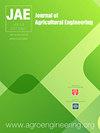Theoretical transmission analysis to optimize Gearbox for a 2.6 kW automatic pepper transplanter
IF 2.5
4区 农林科学
Q2 AGRICULTURAL ENGINEERING
引用次数: 1
Abstract
A gearbox is an essential component of an automatic transplanter to transmit engine power to the transplanter components. It is necessary to find the appropriate gearbox dimensions and materials for the pepper transplanter to minimize transmission losses. Therefore, the objectives of this research were to simulate the power transmission efficiency of the gearbox, and to determine a suitable number of stages, and materials and the dimensions of the spur gears. A 2.6 kW gasoline engine was considered as the prime source to power the entire transplanter. The available maximum length between the engine and transplanter subsystem was 422 mm. By considering design issues, a simulation model was created to determine the efficiency of the pepper transplanter gearbox, including various types of mechanical losses in the gearing system. Three different modules (1, 2, and 3 mm) and two materials were used to evaluate the effects on transmission. The analysis results indicated that the gearbox transmission efficiency levels of seven to twelve stages were in the range of 93.0–98.7%, whereas the eight-stage gearbox yielded the maximum efficiency of 98.7%, greater than our target efficiency of 98.0%. Therefore, an eight-stage gearbox was selected for power transmission to the components. The power transmission simulation results showed that the overall efficiency from engine to transplanting mechanism shaft varied in range of 95.2–95.9% owing to contact of the gear meshes. The analysis results also indicated that the 25CrMo4 carbon steel material with a 2-mm module gear was appropriate for the pepper transplanter. The analysis in this paper can be used as reference in the design of pepper transplanter gears and gearboxes with suitable material properties to provide the desired efficiency.2.6 kW辣椒自动插秧机变速箱优化的理论传动分析
变速箱是自动移栽机的重要部件,用于将发动机动力传递给移栽机各部件。为辣椒插秧机寻找合适的齿轮箱尺寸和材料,以尽量减少传动损失。因此,本研究的目的是模拟齿轮箱的动力传输效率,并确定合适的级数,以及正齿轮的材料和尺寸。一台2.6千瓦的汽油发动机被认为是整个移栽机的主要动力来源。发动机与移栽子系统之间的最大可用长度为422 mm。考虑到设计问题,建立了一个仿真模型来确定插秧机齿轮箱的效率,包括传动系统中各种类型的机械损失。使用三种不同的模块(1、2和3mm)和两种材料来评估对传输的影响。分析结果表明,7 ~ 12级齿轮箱的传动效率水平在93.0 ~ 98.7%之间,其中8级齿轮箱的最高效率为98.7%,高于98.0%的目标效率。因此,选择了一个8级变速箱来将动力传递给组件。动力传动仿真结果表明,由于齿轮啮合的接触,从发动机到移栽机构轴的总效率在95.2 ~ 95.9%之间变化。分析结果还表明,25CrMo4碳钢材料配2 mm模数齿轮是辣椒插秧机的适宜材料。本文的分析可为辣椒插秧机齿轮和齿轮箱的设计提供参考,使其具有合适的材料性能,以达到预期的效率。
本文章由计算机程序翻译,如有差异,请以英文原文为准。
求助全文
约1分钟内获得全文
求助全文
来源期刊

Journal of Agricultural Engineering
AGRICULTURAL ENGINEERING-
CiteScore
2.30
自引率
5.60%
发文量
40
审稿时长
10 weeks
期刊介绍:
The Journal of Agricultural Engineering (JAE) is the official journal of the Italian Society of Agricultural Engineering supported by University of Bologna, Italy. The subject matter covers a complete and interdisciplinary range of research in engineering for agriculture and biosystems.
 求助内容:
求助内容: 应助结果提醒方式:
应助结果提醒方式:


